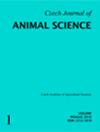Differences between chemical analysis and portable near-infrared reflectance spectrometry in maize hybrids
IF 1.4
4区 农林科学
Q3 AGRICULTURE, DAIRY & ANIMAL SCIENCE
引用次数: 0
Abstract
The aim of this study is to compare the differences between four maize hybrids in terms of nutrient determination by portable near-infrared reflectance spectrometer (pNIRS) and chemical analysis; each of the hybrids was grown in the same locality from 2018 to 2020. The topic relates to the variability of the feed value of maize being an important feedstuff in livestock nutrition. The nutritional values determined by pNIRS in comparison with the chemical analysis were higher (P < 0.001) in starch and ash content but lower in dry matter, neutral detergent fibre and crude protein (CP) content. The digestibility levels of neutral detergent fibre and the net energy of lactation as well as the potential milk production per hectare in relation to each tonne of dry matter were also lower. According to this result, it would be necessary to calibrate all tested indicators for a given spectrometer. However, the pNIRS results are useful for evaluating nutrient variability; the standard deviation of the values found in pNIRS was mostly lower than that determined chemically. The pNIRS results are also useful for making practical adjustments to the total mixed rations when calculated from actual chemical analysis if the correlation between the two methods is used; the correlation between the pNIRS and chemical results was found to be significant (P < 0.05) in terms of all the indicators.玉米杂交品种化学分析与便携式近红外光谱分析的差异
本研究比较了4个玉米杂交种在便携式近红外光谱仪(pNIRS)测定养分和化学分析方面的差异;每种杂交品种都是在2018年至2020年期间在同一地点种植的。本课题涉及玉米作为家畜营养中的重要饲料,其饲料价值的变异性。与化学分析相比,pNIRS测定的营养价值淀粉和灰分含量较高(P < 0.001),干物质、中性洗涤纤维和粗蛋白质含量较低(P < 0.001)。中性洗涤纤维消化率、泌乳净能和每吨干物质每公顷潜在产奶量也较低。根据这一结果,有必要对给定光谱仪的所有测试指标进行校准。然而,pNIRS的结果对评估养分变异性是有用的;在pNIRS中发现的值的标准偏差大多低于化学测定的值。如果使用两种方法之间的相关性,则pNIRS结果也可用于根据实际化学分析计算总混合比时的实际调整;pNIRS与化学结果在各指标上均有显著相关性(P < 0.05)。
本文章由计算机程序翻译,如有差异,请以英文原文为准。
求助全文
约1分钟内获得全文
求助全文
来源期刊

Czech Journal of Animal Science
Agriculture, Dairy & Animal Science-奶制品与动物科学
CiteScore
2.40
自引率
16.70%
发文量
44
审稿时长
5 months
期刊介绍:
Original scientific papers and critical reviews covering all areas of genetics and breeding, physiology, reproduction, nutrition and feeds, technology, ethology and economics of cattle, pig, sheep, goat, poultry, fish and other farm animal management. Papers are published in English.
 求助内容:
求助内容: 应助结果提醒方式:
应助结果提醒方式:


